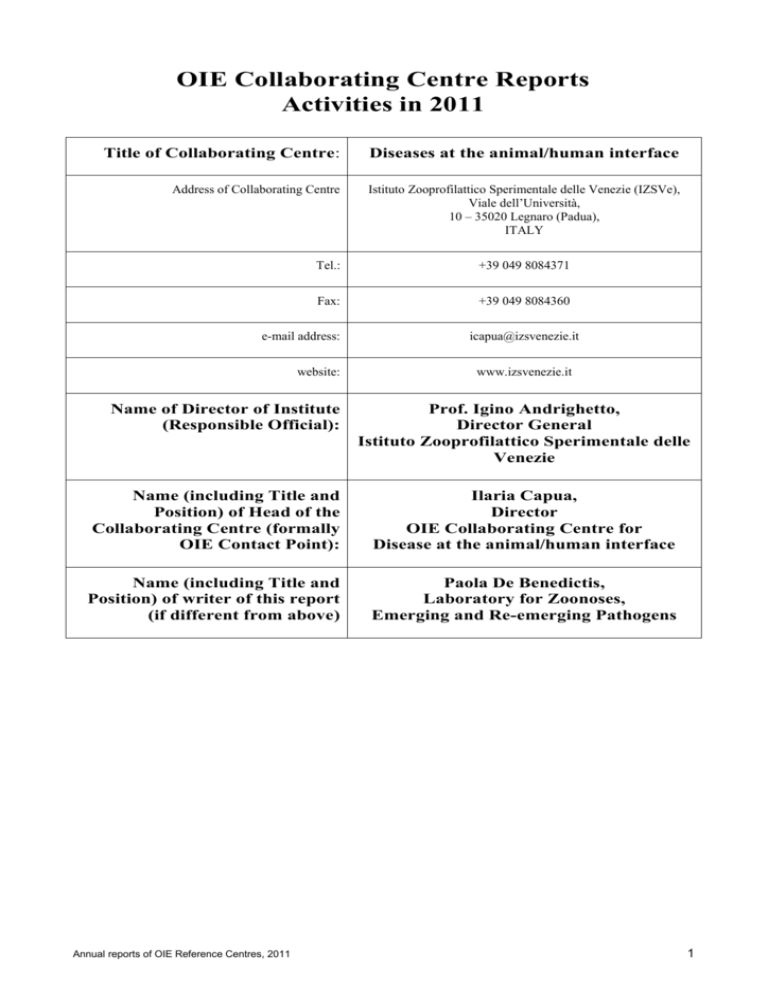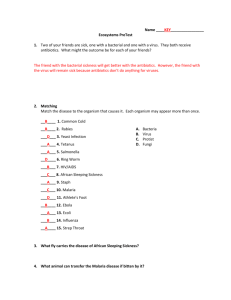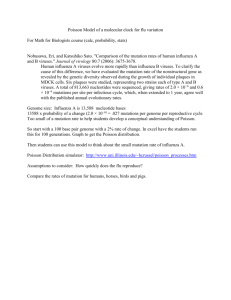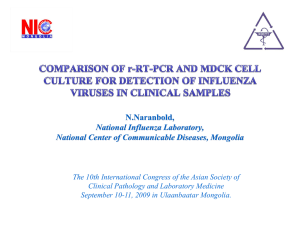African horse sickness
advertisement

OIE Collaborating Centre Reports Activities in 2011 Title of Collaborating Centre: Diseases at the animal/human interface Address of Collaborating Centre Istituto Zooprofilattico Sperimentale delle Venezie (IZSVe), Viale dell’Università, 10 – 35020 Legnaro (Padua), ITALY Tel.: +39 049 8084371 Fax: +39 049 8084360 e-mail address: website: Name of Director of Institute (Responsible Official): icapua@izsvenezie.it www.izsvenezie.it Prof. Igino Andrighetto, Director General Istituto Zooprofilattico Sperimentale delle Venezie Name (including Title and Position) of Head of the Collaborating Centre (formally OIE Contact Point): Ilaria Capua, Director OIE Collaborating Centre for Disease at the animal/human interface Name (including Title and Position) of writer of this report (if different from above) Paola De Benedictis, Laboratory for Zoonoses, Emerging and Re-emerging Pathogens Annual reports of OIE Reference Centres, 2011 1 Diseases at the animal/human interface Summary of activities specifically related to the mandate of OIE Collaborating Centres 1. Activities as a centre of research, expertise, standardisation and dissemination of techniques within the remit of the mandate given by the OIE Selection of a panel of H1, H2 and H3 human influenza viruses and contemporary homosubtypic animal influenza viruses for the evaluation of human cross-protective antibody activity Phylogenetic, antigenic site and receptor binding properties of the HA gene of eighty-three animal influenza viruses of the H1, H2 and H3 subtype, available from the IZSVe repository, were investigated to select representative viruses to be used for the evaluation of human cross-protective Ab activity. Twenty-seven representative animal influenza viruses of the H1 (9 viruses), H2 (4 viruses) and H3 (14 viruses) subtypes isolated in Eurasia and Africa from distinct host species were selected among the eighty-three viruses available and tested against 100 human sera by microneutralization (MN) assay. The results of this serologic study show that human serum specimens exhibited a different degree of cross-reactivity with animal influenza viruses. Antibodies against human H1 influenza viruses do not cross-react with contemporary Eurasian lineage avian influenza (AI) viruses of the H1 subtype. Interestingly, human serum samples exhibited the highest degree of crossreactivity with swine influenza (SI) viruses. A retrospective serological survey on pandemic H1N1 influenza virus in the canine population of Northern and Central Italy We recently reported serological evidence for infection of pet dogs by A(H1N1)pdm09 during the first peak in 2009. To further investigate the A(H1N1)pdm09 situation in dogs we undertook a second serological study on samples originating from dogs residing in Central and Northern Italy between January 2010 and February 2011. Our findings indicate that the virus is circulating to some extent in the domestic dogs populations from which the samples originated. Further epidemiological studies carefully designed to attempt to generate data on the prevalence of on-going infection and evidence of human to dog transmission are nevertheless recommended in order to investigate the epidemiology of A(H1N1)pdm09 among dogs population and to overall monitor the virus circulation. Survey on circulation of influenza type A in the swine population of Cameroon A pilot study was conducted in collaboration with the University of California-Los Angeles and the Centre Pasteur du Camerun, Youndè to assess the circulation of type A influenza viruses, including the pandemic H1N1, in swines in Cameroon. This study revealed the circulation of the human pandemic H1N1 virus in the animal population for the first time in Africa . Survey of dogs for the occurrence of novel canine Norovirus A novel norovirus (cNoV) detected in faeces from dogs with diarrhoea in Portuguese kennels from 2007 to 2008, has recently been identified and genetically characterized by CDC. IZSVe, in collaboration with CDC, has undertaken a survey study for the presence of such infection in European dogs. As a first step, faeces samples (n=317) collected from puppies living in French kennels and suffering from diarrhoea were analysed by real time-PCR. Sequences were obtained from samples tested positive. Four positive samples out of 317 screened (prevalence of 1.26%) were obtained by Real-Time PCR and were confirmed as cNoV by sequencing. At the nucleotide level the four positive samples were 99.0-100% identical to each other and 97.198.0% identical to the prototype strain Norovirus dog/C33/Viseu/2007/PRT (GenBank GQ44361). Molecular epidemiology and evolution of rabies viruses circulating in Italy from 2008 to 2011 To investigate the genetic diversity of RABV circulating in Italy from 2008 to 2011, all the 287 brain samples collected so far were analysed. Partial sequences of the Nucleoprotein (N) gene and complete sequences of the G gene and the intergenic G-L region were obtained from 287 and 128 selected fox samples, respectively. Preliminary results reveal that viruses circulating in Italy have high similarity with those circulating in the Balkan region and identify two genetic clusters circulating in North-east Italy, indicating the likely occurrence of two distinct introductions from neighbouring areas. Diagnostic activities for Flaviviruses A total of 71 sequence analyses were conducted in the framework of the surveillance activity for Flaviviruses in the Veneto region, Italy in 2011. 2 Annual reports of OIE Reference Centres, 2011 Diseases at the animal/human interface Research activity on Astrovirus Scientific review on the molecular biology, evolution and interspecies transmission on human and animal astrovirus. Research activity on prevalence and risk factors of canine astrovirus. A study conducted in collaboration with the Faculty of Veterinary Medicine, Maison Alfort (F) on the prevalence and risk factor for puppies for canine astrovirus in French kennels. During this study, 316 samples from 33 kennels have been analysed by electron microscopy and RT-PCR. Sequencing and phylogenetic analysis were performed on 33 samples. 2. Proposal or development of any procedure that will facilitate harmonisation of international regulations applicable to the surveillance and control of animal diseases, food safety or animal welfare Provision of genetic and antigenic data on avian influenza viruses We have contributed to the provision of genetic and antigenic data on avian influenza viruses A/H5N1 and A/H9N2 under the coordination of the OFFLU Secretariat and focal points in OIE and FAO headquarters for the biannual WHO vaccine composition meeting in Geneva (CH). Antigenic data were developed in collaboration with the WHO collaborating Centre in Memphis, USA (St Judes Children Hospital) and through a multicenter study with the involvement of two OIE Reference Laboratories in UK (AHVLA, Weybridge) and in Australia (AAHL, Geelong). Development of a new diagnostic assay for differentiating vaccine from field rabies strains in the field We have developed a pyrosequencing protocol for the rapid identification of vaccine-associated rabies cases and have applied this technique to the rabies cases detected during the 2008-2011 Italian epidemic. Results showed no evidence of vaccine-associated cases following fox oral vaccination campaigns, agreeing with previous reports in which vaccine-derived rabies cases were very rare. This investigation also represents a comprehensive screening following SAG2 distribution. The method developed is a valid and sensitive alternative to monoclonal antibody typing within the framework of a post-oral vaccination survey. Comparison of serologic techniques to measure rabies antibodies in red foxes (Vulpes vulpes) for follow-up harmonisation and comparison of the results We have evaluated a) the impact of two different matrixes commonly used for serology in red foxes on the results of a neutralization-based method (NT) and b) the performances of two commercially available ELISAs in comparison with a NT, as a gold standard, using a panel of over 700 field fox samples. Moderate agreement has been observed when comparing results from different matrixes. We found a very low level of agreement and low values of relative sensitivity and specificity of the ELISA tested in comparison with the NT. Our findings confirm with field data the need for harmonising the type of samples and the techniques used for rabies serology in wildlife vaccination follow-up. 3. Networking a) Maintenance of a network with other OIE Collaborating Centres designated for the same specialty, and – b) Should the need arise, maintenance of a network with Collaborating Centres in other disciplines - IZSVe – NCEZID CDC organised in collaboration “One Flu Strategic Retreat” * The executive summary of the retreat is available at: http://www.izsvenezie.it/images/stories/Pdf/eventi/Exec_Sum_final_One_flu_strategic_retreat.pdf - IZSVe-AAHL, Geelong Australia Harmonization of hemagglutination inhibition test on ferret sera and contribution to Vaccine Composition Meeting – WHO, Geneva (in collaboration with AHVLA, Weybridge; OFFLU Secretariat, OIE, Paris; Animal Division, FAO, Rome) Annual reports of OIE Reference Centres, 2011 3 Diseases at the animal/human interface - IZSVe-CIRAD, Montpellier, France Avian Influenza ecology in sub-Saharan Africa. - IZSVe-FAO/IAEA Animal Production and Health Laboratory, Wien, Austria Collaborations and contacts for training and laboratory capacity building. - IZSVe-National Veterinary Institute, Uppsala, Sweden Collaborations in the framework of the application of new molecular technologies (e.g. Next Generation Sequencing) for transboundary animal diseases and emerging and zoonotic pathogens. 4. Placement of expert consultants at the disposal of the OIE During the 2011, this laboratory provided expertise and active participation to the OIE-FAO Influenza Network (OFFLU), in particular to the technical activities concerning Vaccination (team leader David Swayne); training and capacity building (team leader Giovanni Cattoli), Commercial Diagnostic Kit Evaluation (team leader Marek Slomka) through participation to teleconference and meetings. 6-8 June 2011. Final Review Meeting - OFFLU Project for Vaccine Evaluation - Rome, Italy 15th July 2011. OFFLU teleconference to discuss about ferret antisera and review on genetic and antigenic data for WHO-VCM 12th September 2011. OFFLU technical group on capacity building 29th September 2011. OFFLU teleconference on TA Vaccination 19th December 2011. OFFLU teleconference on VCM panels 5. Provision of scientific and technical training, within the remit of the mandate given by the OIE, to personnel from OIE Member Countries From December 2010, the Collaborating Centre has been managing the activities of the RESOLAB rabies subnetwork for 23 Western and Central African veterinary laboratories upon request of UN-FAO. During 2011, a technical questionnaire was distributed to the member laboratories, in both English and French, to assess the diagnostic capabilities for rabies of the laboratories of the network. The results of this inquiry were presented during the annual RESOLAB meeting in Bamako (Mali) in December 2011. Training courses for selected countries in the region will be implemented in 2012 and funded by UN-FAO. In 2011 the Collaborating Centre has organised two training courses funded by DG-SANCO (Better Training for Safer Food) for the diagnosis and control of rabies in the Mediterranean Basin. The first training course was held in November 2011 for twenty participants coming from four countries of the Middle East. The second training course will be held in February 2012 for beneficiaries from Maghreb countries. 6. 21st November– 2nd December 2011. Training course on the sequencing and phylogenetic analysis of Avian Influenza Virus genome. One beneficiary from Nigeria 8th November– 10th November 2011. Better Training for Safer Food, funded by DG-SANCO - Laboratory training course to improve prevention and control of rabies. Twenty participants from four countries of the Middle East region: Egypt, Jordan, Lebanon, Syria 25th October 2011 – 31st January 2012. Internship on serological, virological and molecular techniques according to OIE/EU guidelines for the diagnosis of Avian Influenza. One beneficiary from Italy 18th July– 22nd July 2011. FAO training course on serological, virological and molecular techniques according to OIE/EU guidelines for the diagnosis of Avian Influenza. One beneficiary from Cuba 13th June– 24th June 2011. FAO training course on serological, virological and molecular techniques according to OIE/EU guidelines for the diagnosis of Avian Influenza and Rabies Virus. Two participants from Rwanda and Uganda 18th January – 21st January 2011. Training course on bioinformatics; phylogenetic analyses of influenza viruses from Bulgaria. One participant from Bulgaria Organisation of scientific meetings on behalf of the OIE See point 3.a) above. 4 Annual reports of OIE Reference Centres, 2011 Diseases at the animal/human interface 7. Coordination of scientific and technical studies in collaboration with other laboratories, organisations or collaborating centres Scientific Opinion on monitoring for the emergence of possible new pandemic strains of influenza in animals. On request from EFSA. The opinion has been published in the EFSA Journal: http://www.efsa.europa.eu/en/efsajournal/pub/2109.htm FLUTRAIN. Training and technology transfer of Avian Influenza diagnostics and disease management skills. The aim of the project was to provide comprehensive training and the transfer of technology to accession and International Cooperation Countries (INCO) with the clear goal of aiding these countries in combating AI with the most up-to-date diagnostic and disease management procedures. The global outbreaks of pandemic (H1N1) 2009 highlighted the unpreparedness of many laboratories to manage this crisis particularly if the virus infected pig populations. The project was amended so that important tools and information on the immunity of pig populations to pandemic H1N1 could be generated and transferred to laboratories in developing countries. The consortium included eleven members (including two SMEs) in addition to eight associated partners, many of whom were recipients of training. 8. Publication and dissemination of any information within the remit of the mandate given by the OIE that may be useful to Member Countries of the OIE Presentations at international conferences and meetings 1. Arcangeli,G.; Terregino,C.; De Benedictis,P.; Rosteghin,M.; Zecchin,B.; Manfrin,A.; Rosetti,E.; Rovere,P.; Mancin,M.; Brutti,A. (2011); Effect of High Hydrostatic Pressure on Murine Norovirus in Manila clams. 8th International Conference on Molluscan Shellfish Safety; Charlottetown (Prince-Edward Island, Canada) 1317 June 2011 2. Capua,I.; Cattoli,G. (2011); One health, one flu? European Journal: Tropical Medicine and International Health. Proceedings of the 7th European Congress on Tropical Medicine and International Health, Barcelona 3-6 October 2011; 16(1):30 3. Capua,I.; Cattoli,G. (2011); One Health, One Flu? International Meeting on Emerging and Infectious Diseases and Surveillance - Final program; Vienna (Austria) 4-7 February 2011 4. Capua,I.; Monne,I.; Cattoli,G. (2010); One Flu - a novel approach to influenza virus. 23° Rencontres sur la grippe et sa prévention - Programme & Résumés, 13-25; Parigi (Francia) 25-26 November 2010 5. Capua,I.; Monne,I.; Cattoli,G. (2011); One Flu - a novel approach to influenza virus infections. Options for the control of influenza VII; Hong Kong SAR (China) 3-7 September 2010 6. Chaudhry,M.; Rashid,H.B.; Angot,A.; Trovò,G.; Drago,A.; Valastro,V.; Thrusfield,M.; Hussain,M.; Eisler,M.; Welburn,S.; Cattoli,G.; Capua,I. (2011); H9N2 avian influenza reassortants in live bird retail shops in Pakistan contain signatures of public health concern. International Meeting on Emerging and Infectious Diseases and Surveillance (IMED 2011) - Final program; Vienna (Austria) 4-7 February 2011 7. Comin,A.; Capello,K.; Mulatti,P.; Gagliazzo,L.; Citterio,C.; De Benedictis,P.; Mutinelli,F.; Bonfanti,L.; Marangon,S. (2010) Impact of emergency oral rabies vaccination of foxes in Northeastern Italy. ESCAIDE 2010; Lisbona (Portogallo) 11-13 November 2010 8. De Benedictis,P.; Cattoli,G.(2011); RESOLAB sub-network on rabies. 10th International SEARG Conference (Southern and Eastern Africa Rabies Group); Maputo (Mozambico) 25-28 January 2011 9. Fusaro,A.; Monne,I.; Salviato,A.; Coven,F.; Dakman,A.; Capua,I.; Cattoli,G. (2011); Impact of vaccination on the genetic evolution of H5N1 viruses in Egypt. International Meeting on Emerging and Infectious Diseases and Surveillance - Final Programme; Vienna (Austria) 4-7 February 2011 10. Mulatti, P., Gagliazzo, L., Lorenzetto, M., Patregnani, T., De Benedictis, P., Mutinelli, F., Guberti, V., Bonfanti, L., Marangon, S. (2011) Evaluation of the 2009–2010 Oral Fox Vaccination (OFV) campaigns in North-Eastern Italy International Meeting on Emerging and Infectious Diseases and Surveillance - Final program; Vienna (Austria) 4-7 February 2011 11. Mutinelli,F.; Bonfanti,L.; De Benedictis,P.; Mulatti,P.; Gagliazzo,L.; Lorenzetto,M.; Marangon,S. (2011); Fox Rabies in Italy. 4th Workshop for Rabies; Nancy (France) 21 September 2011 Annual reports of OIE Reference Centres, 2011 5 Diseases at the animal/human interface Scientific publications in peer-reviewed journals 12. Cattoli G, Fusaro A, Monne I, Coven F, Joannis T, El-Hamid HS, Hussein AA, Cornelius C, Amarin NM, Mancin M, Holmes EC, Capua I. Evidence for differing evolutionary dynamics of A/H5N1 viruses among countries applying or not applying avian influenza vaccination in poultry. Vaccine. 2011 Oct 12. 13. Cattoli G, Milani A, Temperton N, Zecchin B, Buratin A, Molesti E, Aly MM, Arafa A, Capua I. Antigenic drift in H5N1 avian influenza virus in poultry is driven by mutations in major antigenic sites of the hemagglutinin molecule analogous to those for human influenza virus. J Virol. 2011 Sep;85(17):8718-24. 14. Cumming GS, Caron A, Abolnik C, Cattoli G, Bruinzeel LW, Burger CE, Cecchettin K, Chiweshe N, Mochotlhoane B, Mutumi GL, Ndlovu M. “The Ecology of Influenza A Viruses in Wild Birds in Southern Africa”. Ecohealth. 2011 Apr 23. [Epub ahead of print] 15. De Benedictis P, De Battisti C, Dacheux L, Marciano S, Ormelli S, Salomoni A, Caenazzo ST, Lepelletier A, Bourhy H, Capua I, Cattoli G. Lyssavirus detection and typing using pyrosequencing. J Clin Microbiol. 2011 May;49(5):1932-8. 16. De Benedictis P, Schultz-Cherry S, Burnham A, Cattoli G. Astrovirus infections in humans and animals Molecular biology, genetic diversity, and interspecies transmissions. Infect Genet Evol. 2011 Oct;11(7):1529-44. 17. Fusaro A, Monne I, Salviato A, Valastro V, Schivo A, Amarin NM, Gonzalez C, Ismail MM, Al-Ankari AR, Al-Blowi MH, Khan OA, Maken Ali AS, Hedayati A, Garcia Garcia J, Ziay GM, Shoushtari A, Al Qahtani KN, Capua I, Holmes EC, Cattoli G. Phylogeography and evolutionary history of reassortant H9N2 viruses with potential human health implications. J Virol. 2011 Aug;85(16):8413-21. Epub 2011 Jun 15. 18. Gaidet N, Caron A, Cappelle J, Cumming GS, Balança G, Hammoumi S, Cattoli G, Abolnik C, Servan de Almeida R, Gil P, Fereidouni SR, Grosbois V, Tran A, Mundava J, Fofana B, Ould El Mamy AB, Ndlovu M, Mondain-Monval JY, Triplet P, Hagemeijer W, Karesh WB, Newman SH, Dodman T. Understanding the ecological drivers of avian influenza virus infection in wildfowl: a continental-scale study across Africa.Proc Biol Sci. 2011 Oct 7. [Epub ahead of print] 19. Grellet A., De Battisti C, Feugier A, Pantile M, Marciano S, Grandjean D, Cattoli G. Prevalence and risk factors of astro virus infection in puppies in French breeding kennels. Veterinary Microbiology (2011), epublished ahead of print 20. Njabo KY, Fuller TL, Chasar A, Pollinger JP, Cattoli G, Terregino C, Monne I, Reynes JM, Njouom R, Smith TB. Pandemic A/H1N1/2009 influenza virus in Swine, Cameroon, 2010. Vet Microbiol. 2011 Sep 12. _______________ 6 Annual reports of OIE Reference Centres, 2011





